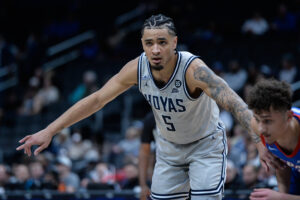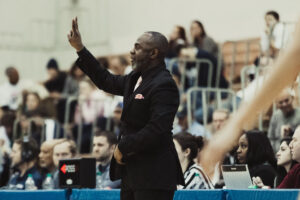Aurea Gingras, sophomore point guard for Paul VI High School’s women’s basketball team, stood in the corner as the seconds ticked down in the 2018 Washington Catholic Athletic Conference (WCAC) championship semifinal. As a facilitator, Gingras hadn’t shot the ball at all in the game. In fact, her coaches encouraged her not to shoot.
Paul VI, trailing McNamara 60-61, placed its final hopes of completing a 13-point comeback in the hands of star guard Ashley Owusu. Owusu drove, collapsed the defense, and kicked the ball out to Gingras. This time, Gingras ignored her coaches’ directives not to shoot.
“Instinct, or the basketball gods, kick in, and take the ball out of my hands,” Gingras recalls. “I shot it from the corner, and it goes in.”
Her teammates stormed the court and the crowd erupted, triggering what Gingras characterizes as an “out-of-body experience.” After the emotions wore off, Gingras was able to process what she had just achieved: a game-winning three to send Paul VI to the WCAC championship game.
Subsequent media coverage discussed the magnitude of Gingras’s shot for Paul VI, a perennial powerhouse of girls’ high school basketball in the DMV. What stayed under the radar in the game’s aftermath, though, was a hidden trend that Gingras’s shot epitomized: the increasing importance of Filipino Americans in the DMV high school basketball scene.
When Gingras was 8 years old, she became connected to a wider network of Filipino hoopers in the DMV when she joined the Filipino Youth Basketball Association (FYBA), a nonprofit that offers training and organizes leagues for Filipino youth in the DMV. After joining FYBA and getting serious about training, she became a sought-after middle school recruit, a varsity starter in high school, and eventually a rotation player on George Washington University’s team.
FYBA has helped several other Filipino youth earn college basketball scholarships in recent years and dozens more make their high school varsity teams. Russell Casapao, the director of FYBA, established the nonprofit in 2007 to platform young Filipino hoopers, a group that often gets overlooked in the DMV basketball scene.
Aside from helping young Filipinos play competitively, FYBA has had another effect on Filipino youth in the DMV: fostering their Filipino identity. In the DMV, basketball has emerged as a way for second- and third-generation Filipino Americans, who otherwise might have limited exposure to Filipino culture, to live in community with other Filipinos and absorb cultural knowledge from elders. The role of basketball in facilitating cultural preservation among Filipinos was far from inevitable, though. Their famed love of basketball stems from the United States’s attempts to assimilate Filipinos into American culture, a goal Filipinos have since subverted.
This December marks the 125th anniversary of the 1898 Treaty of Paris, which ended the Spanish-American War and transferred colonial control of the Philippines to the United States. For some, this equates to the 125th year of Philippine-American history. For others, this year signifies the 125th anniversary of Philippine independence.
“On June 12, 1898, the Philippines declared independence, and basically the Treaty of Paris ignored that in December of 1898,” Erwin Tiongson, economics professor and author of Philippine-American Heritage in Washington, D.C., said.
After defeating Filipino revolutionaries in the brutal Philippine-American War, which killed up to 200,000 Filipino civilians, according to Tiongson, the United States viewed itself as having a duty to “Americanize” the “primitive” Filipino people and transform the Philippines into a modern state. In the early years of colonization, one tool of Americanization emerged as particularly effective in the Philippines: sports. Basketball, in particular, took hold in the Philippines when YMCA directors helped implement the sport into physical education curricula, Lou Antolihao said. Antolihao wrote Playing with the Big Boys, a book about the United States’s use of basketball as an imperialist tool in the Philippines.
At St. Augustine Seminary in Mindoro, Philippines, where Russell Casapao graduated high school in 1987, students could choose from a range of sports to play in their physical education class. Growing up, Casapao’s sport was baseball. His first exposure to basketball was through his friends in high school, who at first were bigger fans of the sport than he was.
“When my friends watched basketball, I actually hated it,” Casapao remembered. “Why would you just watch these people run back and forth?”
Eventually, Casapao relented and started playing with his friends. After picking up some skills from his friends and making the school’s varsity team, Casapao fell in love with the game.
Casapao moved to the United States in 1997, when he received an IT job opportunity in Houston. He bounced between different states before settling down with his wife, Jingle, in Virginia in 2000. When his sons began playing competitive basketball, Casapao learned about the training opportunities available for children in the United States, opportunities that far exceeded anything available to him in the Philippines. He also noticed that Filipino kids were often overlooked in DMV basketball programs due to perceptions that they are undersized and less athletic. Casapao’s observations, along with his passion for Filipino basketball, convinced him of the need for basketball training catered toward Filipino youth in the DMV, a gap he thought he was equipped to fill.
Since founding FYBA in 2007, Casapao and his team of volunteers have turned FYBA into a household name for Filipino youth involved in the DMV basketball community. On Sundays, Filipino kids aged 8 to 16 pack into Lake Braddock Secondary School’s gym for two hours to play in FYBA’s “house league.” On the perimeter of Lake Braddock’s basketball courts, parents, family members, and coaches catch up with one another in what has become a ritualized weekly activity for many. “I look at it kind of like church,” said Mitch Luz, a coach in FYBA’s 12-and-under age division.
Motivated by the goal of breaking down barriers that restrict Filipinos from participating in competitive basketball, Casapao formed the FYBA Select Team, a program that places its players in tournaments with competitive AAU teams. Members of the FYBA Select Team receive additional training focused on fundamentals. Jaden Ignacio, one of FYBA Select’s earliest players, first garnered the attention of college scouts when Casapao sponsored him to participate in a showcase camp in the Philippines. The camp firmed Ignacio’s trajectory to become a four-year starter at Mary Baldwin University, making him one of many FYBA alumni to play college basketball.
Aurea Gingras has played three years of college basketball. She’s played in two high school state championship games. The biggest crowd she’s played in front of wasn’t at either of those venues. Instead, it was at a 2012 Filipino Labor Day tournament in Canada.
As Gingras took center stage in a gym of six basketball courts to compete in the tournament’s championship game, the scent of adobo and pancit wafted from the back of the facility where parents were cooking. Filipino flags blanketed the crowd. Fans in the stands shook noisemakers and empty water bottles filled with coins until Todd Lancaster, Gingras’s coach, couldn’t hear himself talk. The only audible words were those in Tagalog shouted by spectators, constantly attempting to one-up opposing fan bases in volume and energy. “I haven’t seen an event that has more Filipinos than NABA,” said Casapao.
The North American Basketball Association (NABA) hosts tournaments for Filipino teams from Canada and across the United States every Labor Day weekend. FYBA sends teams to represent the DMV area. With Filipinos from two countries packed into one gym, coaches and players experience unparalleled levels of energy. “The crowds are ridiculous compared to AAU tournaments,” Lancaster said. “I mean, it’s just phenomenal.”
In one play of the championship game, Gingras led a fast break and crossed the ball over, and her defender fell. She crossed it over again, and another defender fell. Gingras doesn’t think her moves were that remarkable, but the crowd’s reaction was even louder than when she hit the game-winning three against McNamara in the conference semifinal. “I’ve made some big plays in my career,” Gingras said. “I don’t think I’ve ever had a moment that was louder than those people falling.”
Gingras identifies as one-quarter Filipino. She’s never been to the Philippines and her family didn’t talk much about Filipino culture while she was growing up, so Gingras didn’t feel connected to her Filipino heritage, she said. That changed when she got involved with FYBA.
At NABA tournaments, where Filipino dance, language, and food are pervasive, Gingras received her “slice of culture,” she said. “Most of the aunties would come to me speaking Tagalog until I told them I couldn’t,” Gingras said. “For once in my life, I loved the assumption that I spoke Tagalog.”
Playing basketball with other Filipinos led Gingras on a journey of discovery about Filipino culture. She sought out Filipino restaurants and discovered and befriended other Filipinos in the DMV. Her brother, who also played with FYBA, spent time cooking in a Filipino kitchen. “It wasn’t even a thing until I was a part of FYBA that I knew what being Filipino was,” Gingras said.
Jerry Bautista, who coaches in FYBA’s 10-and-under age division, agreed with Gingras’s perspective on the capacity of FYBA to strengthen Filipino identity. He said FYBA plays a similar role to Filipino American community centers, which kept him connected with his family’s culture while he was growing up in Florida. While driving his players to practice, Bautista’s ears perked up when he heard his son’s friends profess their love for sinigang, a Filipino vegetable soup. “My son hates vegetables, so I tried to rub it in his face,” Bautista said.
After playing AAU and drawing the attention of scouts, Gingras played two years of high school basketball at Paul VI, which ESPN ranked the top girls’ high school basketball program in the country her freshman year. She rode the bench that year, so Gingras committed herself to a workout plan to earn playing time. On a typical day, she’d lift weights after school, drive home, drive to the basketball gym for skills training, and then drive back home to complete an additional set of exercises, which included a four-minute wall sit.
In hindsight, she realizes her routine and intensity took a toll on her physical and mental health, which initiated a deterioration of her relationship with basketball. Gingras, now a senior at George Washington University, is taking a break from basketball this year, and she intends to use her time off to repair her relationship with basketball and reprioritize her health.
In her freshman year of college, the Philippine women’s national basketball team reached out to Gingras about the possibility of her eventually joining. The request would have seemed odd to a younger Gingras, less aware of her Filipino roots, but after nurturing her Filipino identity with FYBA, the dream of competing on behalf of the Philippines is one of her main motivators to return to the court.
“I’m hoping that as I transition back into playing and transition back into being a part of basketball, that representing the Philippines on the court is something that I can do one day, because I feel like that’s just perfectly full-circle to me,” Gingras said. “I really did get my start with basketball through FYBA and through this Filipino community, and to be on the court again wearing Philippines across my chest would be something incredibly special.”




